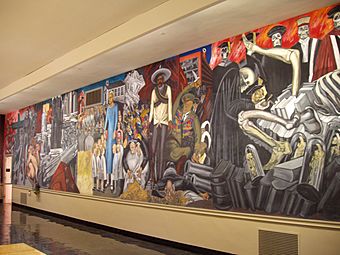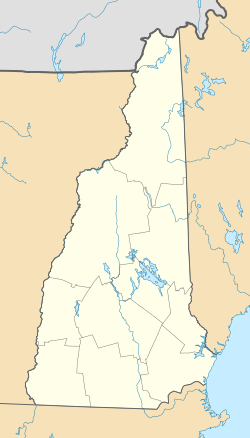The Epic of American Civilization facts for kids
Quick facts for kids |
|
|
The Epic of American Civilization
|
|
 |
|
| Location | Baker Memorial Library, Dartmouth College, Hanover, New Hampshire |
|---|---|
| Built | 1932 |
| NRHP reference No. | 13000283 |
| Added to NRHP | February 27, 2013 |
The Epic of American Civilization is a huge painting called a mural by the artist José Clemente Orozco. He was a "social realist" painter, meaning he painted about real-life issues and people. You can find this amazing artwork in the basement of the Baker-Berry Library at Dartmouth College in Hanover, New Hampshire.
Orozco painted this mural between 1932 and 1934. It's made up of 24 fresco panels. A fresco is a painting done on wet plaster. The main ideas in the mural are about how both Native Americans and European settlers changed North America. It also shows the effects of war, like the Mexican Revolution and World War I, and how fast new industries changed people's lives.
Orozco created this mural around the same time another famous muralist, Diego Rivera, was painting in New York. Rivera's mural was painted over because it included a picture of Lenin, a communist leader. But Orozco was allowed to paint whatever he wanted. Some parents from Dartmouth, who called themselves the "Boston Mothers," were upset by his art. They even wrote to the college president, Ernest Martin Hopkins, asking him to destroy the paintings. One letter even said Orozco's art was like a "Communist Manifesto!"
But President Hopkins, who was a Republican, stood up for Orozco's right to paint freely. He told the mothers that art shouldn't be limited by race or country. He also said that if art had to be "nice," many famous old paintings would have to be removed from museums. In 2013, the mural was named a National Historic Landmark, which means it's a very important historical place.
About the Mural
This mural was the third and last work Orozco painted in the United States. Before this, he painted Prometheus at Pomona College and another mural series at The New School in New York City.
Native American Stories
The mural's two main themes are shown in different parts of the reading room. The west side of the room has ten panels that tell stories about Native Americans.
The Journey Begins
Migration
This panel is on a short wall to the left of the doors. It shows Native Americans arriving in a serious march. This scene reminds us of the industrial panels at the other end of the room.
Snake and Spears
Above the western doors, this panel shows a rattlesnake with spears on each side. Its colors suggest it was painted around the same time as the panels on the eastern side.
Ancient Warriors
This panel and the next four are on the north wall of the west side. This one shows Aztec warriors dressed as eagles and jaguars. It also includes the head of the feathered serpent god, Quetzalcoatl.
Quetzalcoatl Arrives
Quetzalcoatl is shown as a kind god in human form. He brings education and culture to his people and drives away older gods.
A Golden Age
Thanks to Quetzalcoatl, people learn about farming, art, and science, leading to a golden age. One person is farming, another is carving a stone stele (a tall stone slab), and a third is studying the stars.
Quetzalcoatl Leaves
Followers of the old gods team up to make Quetzalcoatl leave. Sorcerers stand in front of a pyramid-shaped temple, opposing the god as he departs.
The Prophecy
This small panel, above a door, shows Spanish conquistadors on horseback. They are holding a giant Christian cross like a weapon.
Totem Poles
These two tall panels are on poles in the western part of the room. They are like funny pictures of totem poles from the Pacific Northwest.
European Arrival and Modern Times
The other main theme of the mural is about the arrival of Europeans and the modern world.
Modern Industry
Machine Totems
These tall panels show modern factory themes, similar to totem poles. They are on poles in the eastern part of the room.
Cortez and the Cross
This panel and the next four are on the south wall of the eastern side. Orozco shows Hernán Cortés as a harsh leader during the 16th-century Spanish conquest of the Aztec Empire. This fulfills the prophecy of Quetzalcoatl. Cortés is surrounded by destruction, with a cross-carrying Franciscan friar by his side.
The Machine
This panel shows the change to the 20th century. It depicts a large pile of machines that don't seem to have a clear purpose.
Life in North America
Orozco shows a mixed view of society in North America. There's a schoolhouse and a town meeting, but a strict teacher controls the scene, and the meeting seems very rigid.
Life in Latin America
A modern Mexican rebel, looking like Emiliano Zapata, stands over a funny picture of a rich and military-focused society.
Modern Gods
This panel criticizes how the church seemed to ignore the big social changes happening in the 1930s. Flames in this panel remind us of the first panel in this section.
Symbols of Nations
This small panel, above a door on the north wall of the east side, shows a pile of old symbols of war and empires.
Modern Sacrifice
Like the "Ancient Human Sacrifice" panel on the west side, this one shows a soldier's body wrapped in patriotic symbols. It means that individuals are sometimes sacrificed for institutions without a good reason. This panel is to the left of the easternmost doors.
New Spirit
This panel shows Jesus sweeping away old religious and political ideas. He discards symbols of religion, culture, and the military. This panel is to the right of the easternmost doors.
Chains of Control
This panel, above doors on the south side of the eastern half, shows vultures wearing religious collars. They hold keys to chains of slavery piled below them.
Modern Workers
This is a group of five panels located near the reserve reading desk. Orozco shows his idea for a possible new world. In this world, workers can benefit from their own hard work, and different cultures can live together peacefully.
See also
 In Spanish: La Épica de la Civilización Americana para niños
In Spanish: La Épica de la Civilización Americana para niños



